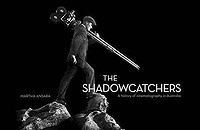Cinematography captures images, playing with light and shade, mood and texture, distance and what is right under our noses. It is very appropriate to call the people who do such work ‘shadowcatchers’, and Martha Ansara is ideally qualified to write about them, as both a cinematographer and director herself. She dedicates the book to her fellow-‘shadowcatchers’, offering a history of their art.
In fact, this book is itself a work of art – from the striking, shadowy image of Lacey Percival carrying his silent film camera and tripod across the rocks on the front cover, to the final backlit, colour image of Peter Menzies and David Elmes on the set of The Great Raid (2005). In between are hundreds of sharply beautiful images – not those we are used to seeing, of stills from a film, but rather capturing the cinematographer at work, or at rest between takes.
The presentation and design of the book – white text, printed on heavy, glossy black paper – enhances these images. Colour appears intermittently from the 1970s, providing another element in the visual impact of the book.
All this makes for a stunning coffee table book – one that would delight anyone who casually picked it up for browsing. Unfortunately, its sheer size and weight make it unwieldy for closer reading. However, it certainly repays the effort, as the story it has to tell is very different from anything so far written about Australian film.
The book announces itself in the title as ‘a history of cinematography in Australia’, and its chronological organization emphasizes the story of change which it has to tell. But this is a complex history, with many threads intersecting across time.
A history of cinematography must, of course, have a technological aspect. The book covers the developments from silence to sound, from black and white to colour, from heavy and unwieldy equipment to light and hand-held. The technical information is there for the expert or enthusiast, but it never overwhelms the less informed reader. There is also frequent reference to the Australian skill in improvisation, which produced on makeshift equipment results as impressive as on the more expensive, imported gear. Recognition is also given to those Australian innovators whose inventions were taken up overseas and became the industry standard – such as the wonderful lens developed by Jim Frazier.
The place and function of cinematography within the film industry has changed dramatically also. In the primitive days, one person might well be the cinematographer, the director, the producer and even sometimes an actor. As the silent film industry developed and differentiation of function gradually superseded this primitive industrial model, the cinematographer ‘s role became clearer and more distinct. In fact the cinematographer’s job became so complex that several people were employed in a hierarchy which provided both job security and training towards the coveted position of Director of Photography. For many years, those who saw their practice as a craft resisted what they thought of as ‘arty’, and it was not until the revival of the feature film industry in the 1970s that this dichotomy seemed to diminish.
A history of cinematography must necessarily include all forms of moving-image-making: documentaries and dramas, short films and longer features, film and television and (more recently) digital images. Though some may prefer working in one more than another, all cinematographers move fluidly among these industry segments, to maintain continuous employment. This book, then, covers all these alternatives much more fluidly than previous film histories have managed, providing an impressive industrial history of film in Australia. The final text of the book summarises how the role of the cinematographer has changed since the introduction and growing dominance of digital technology.
But this book is more than a technological and industrial history: it is also a social history. Like all technology, cinematography has been affected by periods of growth and decline within the society more generally – the boom of the early years of the 20th century, the Great Depression of the 1930s, two World Wars and several other military conflicts that Australia has been a part of. Women have moved into the field of cinematography, as they have moved into so many other formerly all-male preserves. The book’s primary focus is on the cinematographers, providing potted biographies. However, the personal histories of these people constantly comment on the society from which they spring – on education (it can’t be a coincidence that so many cinematographers were dyslexic), on the growth and influence of cities (few cinematographers come from rural areas), on the introduction of women into the field (and their contribution to the women’s movement more generally).
The audience for this book should spread much wider than the members of the Australian Cinematographers Society which sponsored its publication. It would appeal to anyone with a general interest in the history of film-making in Australia. It does what it sets out to do – concisely, completely, convincingly. It will be a long while before it is superseded.
Perhaps this is its most valuable contribution – laying the groundwork and so opening up opportunities for further, more specialized studies. There are occasions when Ansara describes just how difficult it was to achieve a certain effect, and at that point I would have appreciated seeing the result, perhaps in the form of a tiny insert of a still within the image of the cinematographer at work. But I realized that this really belongs in another book, one relating the technology to the images achieved. I hope, if someone does something of that kind, that the result could be as accessible to the general reader as this book is.

